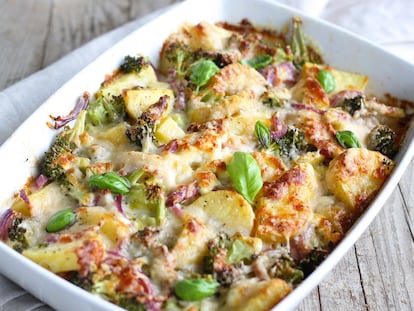Pressure cookers: The story behind a brilliant invention and recipes that go beyond stew
The modern version of the ‘digester’ created by Denis Papin in 1682 is unbeatable for cooking a lot more things than we think in record time, from rice to crème caramel to yes, even octopus
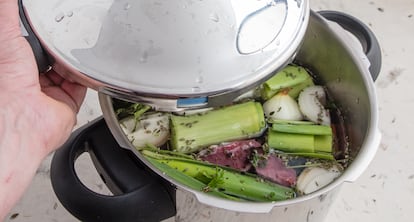
It’s the 1980s. My sister and I are back from school, walking up the stairs of our apartment block amid the whistling sounds and aromas from the pressure cookers going full blast in every home. As we reach our landing, we sniff the air like bloodhounds, hoping that the rattling valve on our mother’s cooker will reveal what we are about to eat, whether it is stewed meat, lentils or chicken with tomato: everything is possible inside that magical container.
We do not know what smells filled the Royal Society of London in April 1682 when Denis Papin offered a meal cooked with his “digester” to the most illustrious scientists in England. We do not know if Isaac Newton, who was present at the event, ordered a jar of beef jelly just like John Evelyn, who recounted the “delicious experiment” in his diary.
The name that Papin gave to his device, “digester,” defines its usefulness: cooking and tenderizing hard foods with minimal expenditure of time and fuel, a process at which the pressure cooker remains unrivaled. In the brochure of the invention, Papin offered recipes for mutton and lamb, veal, rabbit, pigeon meat, fish and legumes, and issued instructions on how to make a very cheap jelly or preserve mackerel without the need for salt. The brochure offered formulas for drinks and sweets, but also for dyes and glass glue. The artifact amazed the onlookers. “The hardest bones of beef itself, and mutton, were made as soft as cheese,” wrote Evelyn. “Without water or other liquor, and with less than eight ounces of coals, producing an incredible quantity of gravy; and for close of all, a jelly made of the bones of beef, the best for clearness and good relish, and the most delicious that I had ever seen, or tasted.” Evelyn confessed to having taken home a jar of beef jelly for his wife.
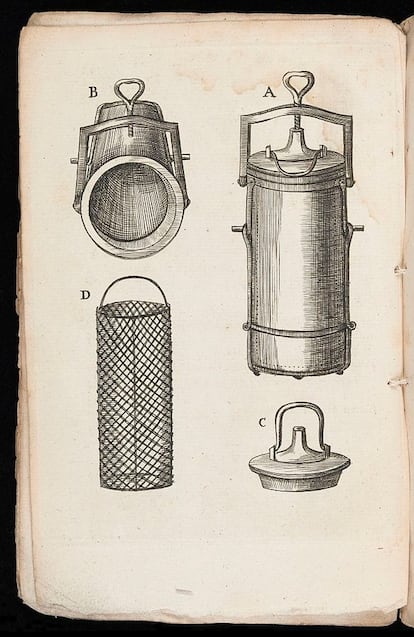
The first pressure cooker was made of brass, but today they are made of aluminum and stainless steel, a material whose hardness guarantees that a pot with good maintenance — scrupulous cleaning and replacement of valves and rubber parts — will be your best ally in the kitchen for life. Another fan of this item is foodie Mikel López Iturriaga, who uses it every time he can. “I can’t understand the reservations that a good part of the population has with this device, which is definitely one of the best inventions ever created for cooking,” he says. “Not only does it save you time and money, there are things that turn out better than in a normal pot. The clearest example is stocks or broths: the capacity of the pressure cooker to extract flavors and aromas from the food and transfer them to the liquid is unbeatable, and you save yourself the hassle of spending hours waiting for them to be ready.” If you think that with this system the broth has a lighter texture than with the traditional one, use this trick: when the pot depressurizes, uncover and cook for about 10 more minutes: you will have the best of both worlds.
The scientist Nathan Myhrvold, former CTO of Microsoft, includes the pressure cooker among the basics of the kitchen of the future in the book Modernist Cuisine: The Art and Science of Cooking (2012). In his vindication of this instrument, he invites readers to experiment: losing the fear of the pressure cooker opens up a world of possibilities in the kitchen. Let’s look at some (calculated for a modern pressure cooker, in older models the cooking times and amount of liquid may vary).
Basmati rice
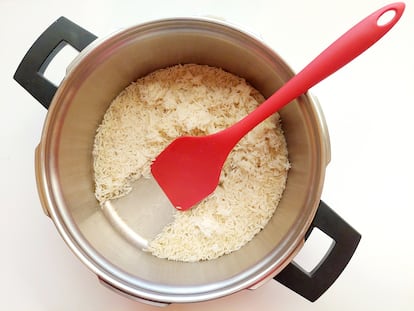
| Cooking time |
|---|
| 7 minutes |
| Ingredients |
| 200 gr rice 200 gr water 30 gr butter or 1 spoonful extra virgin olive oil Salt |
| 1. Set the cooker on the stove, add butter or oil and rice. Stir to coat the grains with the oil/butter. Add water and salt and stir. Close the pressure cooker and cook on high heat until the second line on the valve is visible. 2. Lower the heat and cook for exactly two minutes. Turn off the heat, remove the cooker and allow the valve to go down. This resting time is important so the cooking process can be completed and all the water absorbed. 3. Take out the rice, place in a serving dish and use a fork to separate the grains. |
Round Rice
| Cooking time |
|---|
| 10 minutes |
| Ingredients |
| 200 gr rice 300 gr water (the proportion is 1 to 1.5 in grams) 1 spoonful of extra virgin olive oil Two cloves of garlic, crushed and unpeeled Bay leaf (optional) Salt |
| 1. Heat the oil, add garlic and bay leaf, stir and add the rice. 2. Stir to coat the rice with the oil, add water and salt, close the cooker. 3. When the valve shows two red lines, count three minutes, turn off the heat, remove the cooker from the hob and allow it to depressurize. Open it, remove the garlic and the bay leaf, and transfer to a serving platter. |
Quinoa, buckwheat, millet: Cook like round rice.
Pearled barley, brown rice: Cook like round rice, but with a rice-to-water ratio of 1 to 1.75 (for 200 g of grain, 350 g of water), and time it for five minutes.
Cheese crème caramel in a jar
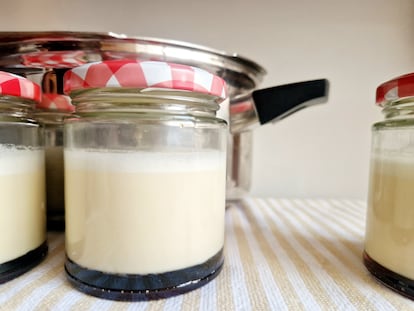
| Cooking time |
|---|
| 10 minutes |
| Ingredients |
| For 8 crème caramels in 200 ml glass jars with screw-on lids |
| For the crème |
| 250 gr of cream cheese 100 gr of fresh goat cheese 4 eggs 400 ml of condensed milk 80 gr of sugar |
| For the caramel |
| 130 gr of sugar 2 spoonfuls of water |
| 1. Place sugar in a microwave-safe bowl, add water and cook at top heat for two minutes. Check and cook for two more minutes. Once the color is right, add to the bottom of the jars. 2. Place the other ingredients in a blender until smooth. Pour into the jars without topping them off. Screw on the lids without making them fully tight. 3. Place the steam accessory at the bottom of the pressure cooker. Place four jars at the bottom, add a glass of water, close the cooker and cook at high heat until the second line of the valve is visible. |
Octopus
| Cooking time |
|---|
| 7 minutes |
| Ingredients |
| A fresh octopus weighing 1.5kg to 2 kg |
| 1. Wash the octopus carefully. Place it inside the cooker without drying it (that water will be enough to cook it). 2. Close the cooker, put on high heat until two lines show up on the valve. Lower the heat and time seven minutes. 3. Allow the cooker to depressurize before opening. Serving suggestion: drizzle with extra virgin olive oil, sweet red paprika and sea salt. |
Sign up for our weekly newsletter to get more English-language news coverage from EL PAÍS USA Edition
Tu suscripción se está usando en otro dispositivo
¿Quieres añadir otro usuario a tu suscripción?
Si continúas leyendo en este dispositivo, no se podrá leer en el otro.
FlechaTu suscripción se está usando en otro dispositivo y solo puedes acceder a EL PAÍS desde un dispositivo a la vez.
Si quieres compartir tu cuenta, cambia tu suscripción a la modalidad Premium, así podrás añadir otro usuario. Cada uno accederá con su propia cuenta de email, lo que os permitirá personalizar vuestra experiencia en EL PAÍS.
¿Tienes una suscripción de empresa? Accede aquí para contratar más cuentas.
En el caso de no saber quién está usando tu cuenta, te recomendamos cambiar tu contraseña aquí.
Si decides continuar compartiendo tu cuenta, este mensaje se mostrará en tu dispositivo y en el de la otra persona que está usando tu cuenta de forma indefinida, afectando a tu experiencia de lectura. Puedes consultar aquí los términos y condiciones de la suscripción digital.
More information
Últimas noticias
Most viewed
- Oona Chaplin: ‘I told James Cameron that I was living in a treehouse and starting a permaculture project with a friend’
- Sinaloa Cartel war is taking its toll on Los Chapitos
- Reinhard Genzel, Nobel laureate in physics: ‘One-minute videos will never give you the truth’
- Why the price of coffee has skyrocketed: from Brazilian plantations to specialty coffee houses
- Silver prices are going crazy: This is what’s fueling the rally
